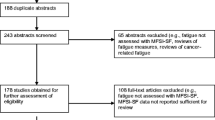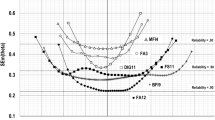Abstract
Although fatigue is one of the most common and debilitating symptoms experienced by cancer patients, it has received little systematic attention. This situation is due in large part to the lack of adequate instruments to measure fatigue. The primary aim of this study was to validate a newly developed measure of fatigue for use with cancer patients: the Fatigue Symptom Inventory (FSI). This 13 item self-report measure was designed to measure the intensity and duration of fatigue and its impact on quality of life. The psychometric properties of the FSI were assessed in women undergoing treatment for breast cancer, women who had completed treatment for breast cancer and women with no history of cancer. A seven-item interference subscale was found to have good internal consistency, with α coefficients above 0.90 in all three groups. The complete FSI was found to have rather weak to moderate test-retest reliability among patients in active treatment and healthy comparison subjects assessed on three separate occasions. Convergent validity was demonstrated using comparisons with existing measures of fatigue. Construct validity was demonstrated using comparisons between and within groups as well as comparisons with measures of anxiety and depression. Overall, the FSI was established as a valid and reliable measure of fatigue in cancer patients and healthy individuals. Suggestions are made for the potential application of the measure in clinical research.
Similar content being viewed by others
References
Winningham ML, Nail LM, Burke MB et al. Fatigue and the cancer experience: the state of knowledge. Oncol Nursing Forum 1994; 21(1): 23–36.
Jamar SC. Fatigue in women receiving chemotherapy for ovarian cancer. In: Funk S et al., eds. Key Aspects of Comfort: Management of Pain and Nausea. Philadelphia: Springer, 1989: 224–228.
Forester B, Kornfeld DS, Fleiss JL. Psychotherapy during radiotherapy: effects on emotional and physical distress. Am J Psychol 1985; 142(1): 22–27.
Greenberg DB, Sawicka J, Eisenthal S, Ross D. Fatigue syndrome due to localized radiation. J Pain Symptom Manage 1992; 7(1): 38–45.
Smets EMA, Garssen ALJ, Schuster-Uitterhoeve ALJ, de Haes JCJM. Fatigue in cancer patients. Br J Cancer 1993; 68: 220–224.
Irvine DM, Vincent L, Bubela N, Thompson L, Graydon J. A critical appraisal of the research literature investigating fatigue in the individual with cancer. Cancer Nursing 1991; 14(4): 188–199.
Kobashi-Schoot JAM, Hanewald GJFP, Van Dam FSAM, Bruning PF. Assessment of malaise in cancer patients treated with radiotherapy. Cancer Nursing 1985; 8(6): 306–313.
Knobf MT. Physical and psychologic distress associated with adjuvant chemotherapy in women with breast cancer. J Clin Oncol 1986; 4(5): 678–684.
Morrow GR, Pandya K, Barry M et al. Chemotherapy-induced fatigue and patient-reported psychological depression (meeting abstract). Proc Am Soc Clin Oncol 1992; 11: A1329.
Cimprich B. A theoretical perspective on attention and patient education. Adv Nursing Sci 1992; 14(3): 39–51.
Cimprich B. Development of an intervention to restore attention in cancer patients. Cancer Nursing 1993; 16(2): 83–92.
Nail LM, Jones LS, Greene DL, Schipper DL, Jensen R. Use and perceived efficacy of self-care activities in patients receiving chemotherapy. Oncol Nursing Forum 1991; 18(5): 883–887.
Whedon M, Ferrell BR. Quality of life in adult bone marrow transplant patients: beyond the first year. Sem Oncol Nursing 1994; 10(1): 42–57.
Smets EMA, Garrsen B, Bonke B, deHaes JC. The Multidimensional Fatigue Inventory (MFI). Psychometric qualities of an instrument to assess fatigue. J Psychosom Res 1995; 39(5): 315–325.
Glaus A. Assessment of fatigue in cancer and non-cancer patients and in healthy individuals. Support Care Cancer 1993; 1(6): 305–315.
Rhoten D. Fatigue and the post-surgical patient. In: Norris CM, ed. Concept Clarification in Nursing. Rockville, MD: Aspen Publishers Inc., 1982: 277–300.
Krupp LB, Larocca NG, Muir-Nash J, Steinberg AD. The fatigue severity scale: application to patients with multiple sclerosis and systemic lupus erythematosus. Arch Neurol 1989; 46: 1121–1123.
McNair DM, Lorr M, Droppleman LF. The Manual for the Profile of Mood States. San Diego, CA: Educational and Industrial Testing Service, 1981.
Nail L, Winningham M. Fatigue. In: Groenwalk SL, Frogge M, Goodman M, Yarbo C, eds. Cancer Nursing: Principles and Practice, 3rd edn. Boston: Jones & Bartlett, 1993: 608–619.
Piper BG, Lindsey AM, Dodd MJ, Ferketich S, Paul SM, Weller S. Development of an instrument to measure the subjective dimension of fatigue. In: Funk S et al., eds. Key Aspects of Comfort: Management of Pain and Nausea. Philadelphia: Springer, 1989: 199–208.
Ware JE, Snow KK, Kosinski M, Gandek B. SF-36 Health Survey: Manual and Interpretation Guide. Boston, MA: New England Medical Center, 1993.
Spielberger CD, Gorsuch RL, Lushene RD. STAI: Manual for the State-Trait Anxiety Inventory. Palo Alto, CA: Consulting Psychologists Press, 1970.
Radloff LS. The CES-D scale: a self-report depression scale for research in the general population. Appl Psychol Meas 1977; 1(3): 385–401.
Strahan R, Gerbasi KC. Short homogeneous versions of the Marlowe-Crowne Social Desirability Scale. J Clin Psychol 1972; 28: 191–193.
Nunnally JM, Bernstein IH. Psychometric Theory, 3rd edn. New York: McGraw-Hill, 1994.
Campbell DT, Fiske DW. Convergent and discriminant validation by the multitrait-multi method matrix. Psychol Bull 1959; 56: 81–105.
Hann DM, Jacobsen PB, Martin SC, Kronish L, Azzarello LM, Fields KK. Fatigue in women treated with bone marrow transplantation for breast cancer: a comparison with women with no history of cancer. Support Care Cancer 1997; 5:44–52.
Smets EMA, Garssen B, Cull A, de Haes JCJM. Application of the multidimensional fatigue inventory (MFI-20) in cancer patients receiving radiotherapy. Br J Cancer 1995; 73(2): 241–245.
Fawzy FI, Cousings N, Fawzy W, Kemeny ME, Elashoff R, Morton D. A structured psychiatric intervention for cancer patients: I. Changes over time in methods of coping and affective disturbance. Arch Gen Psych 1990; 47: 720–725.
Ganz PA. Quality of Life and the patient with cancer: individual and policy implications. Cancer 1994; 74(4): 1445–1452.
Author information
Authors and Affiliations
Rights and permissions
About this article
Cite this article
Hann, D.M., Jacobsen, P.B., Azzarello, L.M. et al. Measurement of Fatigue in Cancer Patients: Development and Validation of the Fatigue Symptom Inventory. Qual Life Res 7, 301–310 (1998). https://doi.org/10.1023/A:1024929829627
Issue Date:
DOI: https://doi.org/10.1023/A:1024929829627




